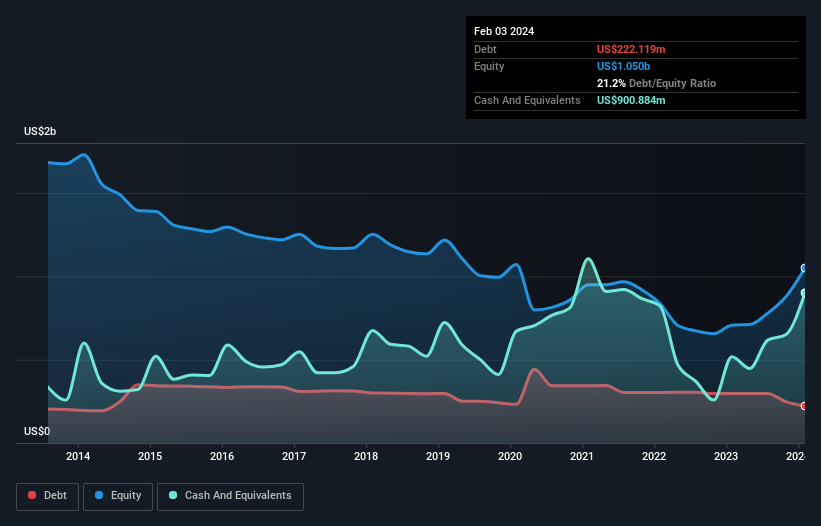Warren Buffett famously said, 'Volatility is far from synonymous with risk.' So it seems the smart money knows that debt - which is usually involved in bankruptcies - is a very important factor, when you assess how risky a company is. We note that Abercrombie & Fitch Co. (NYSE:ANF) does have debt on its balance sheet. But is this debt a concern to shareholders?
Why Does Debt Bring Risk?
Debt is a tool to help businesses grow, but if a business is incapable of paying off its lenders, then it exists at their mercy. In the worst case scenario, a company can go bankrupt if it cannot pay its creditors. However, a more common (but still painful) scenario is that it has to raise new equity capital at a low price, thus permanently diluting shareholders. Of course, plenty of companies use debt to fund growth, without any negative consequences. The first thing to do when considering how much debt a business uses is to look at its cash and debt together.
View our latest analysis for Abercrombie & Fitch
How Much Debt Does Abercrombie & Fitch Carry?
As you can see below, Abercrombie & Fitch had US$222.1m of debt at February 2024, down from US$296.9m a year prior. However, it does have US$900.9m in cash offsetting this, leading to net cash of US$678.8m.

A Look At Abercrombie & Fitch's Liabilities
The latest balance sheet data shows that Abercrombie & Fitch had liabilities of US$966.8m due within a year, and liabilities of US$957.4m falling due after that. Offsetting these obligations, it had cash of US$900.9m as well as receivables valued at US$78.3m due within 12 months. So it has liabilities totalling US$945.0m more than its cash and near-term receivables, combined.
Since publicly traded Abercrombie & Fitch shares are worth a total of US$7.67b, it seems unlikely that this level of liabilities would be a major threat. Having said that, it's clear that we should continue to monitor its balance sheet, lest it change for the worse. Despite its noteworthy liabilities, Abercrombie & Fitch boasts net cash, so it's fair to say it does not have a heavy debt load!
Even more impressive was the fact that Abercrombie & Fitch grew its EBIT by 342% over twelve months. That boost will make it even easier to pay down debt going forward. The balance sheet is clearly the area to focus on when you are analysing debt. But ultimately the future profitability of the business will decide if Abercrombie & Fitch can strengthen its balance sheet over time. So if you want to see what the professionals think, you might find this free report on analyst profit forecasts to be interesting.
But our final consideration is also important, because a company cannot pay debt with paper profits; it needs cold hard cash. While Abercrombie & Fitch has net cash on its balance sheet, it's still worth taking a look at its ability to convert earnings before interest and tax (EBIT) to free cash flow, to help us understand how quickly it is building (or eroding) that cash balance. During the last three years, Abercrombie & Fitch produced sturdy free cash flow equating to 55% of its EBIT, about what we'd expect. This cold hard cash means it can reduce its debt when it wants to.
Summing Up
While Abercrombie & Fitch does have more liabilities than liquid assets, it also has net cash of US$678.8m. And we liked the look of last year's 342% year-on-year EBIT growth. So is Abercrombie & Fitch's debt a risk? It doesn't seem so to us. The balance sheet is clearly the area to focus on when you are analysing debt. But ultimately, every company can contain risks that exist outside of the balance sheet. We've identified 2 warning signs with Abercrombie & Fitch , and understanding them should be part of your investment process.
At the end of the day, it's often better to focus on companies that are free from net debt. You can access our special list of such companies (all with a track record of profit growth). It's free.
New: Manage All Your Stock Portfolios in One Place
We've created the ultimate portfolio companion for stock investors, and it's free.
• Connect an unlimited number of Portfolios and see your total in one currency
• Be alerted to new Warning Signs or Risks via email or mobile
• Track the Fair Value of your stocks
Have feedback on this article? Concerned about the content? Get in touch with us directly. Alternatively, email editorial-team (at) simplywallst.com.
This article by Simply Wall St is general in nature. We provide commentary based on historical data and analyst forecasts only using an unbiased methodology and our articles are not intended to be financial advice. It does not constitute a recommendation to buy or sell any stock, and does not take account of your objectives, or your financial situation. We aim to bring you long-term focused analysis driven by fundamental data. Note that our analysis may not factor in the latest price-sensitive company announcements or qualitative material. Simply Wall St has no position in any stocks mentioned.
About NYSE:ANF
Abercrombie & Fitch
Through its subsidiaries, operates as an omnichannel retailer in the Americas, Europe, the Middle East, Africa, and the Asia-Pacific.
Very undervalued with flawless balance sheet.
Similar Companies
Market Insights
Community Narratives




